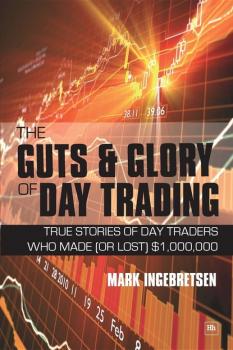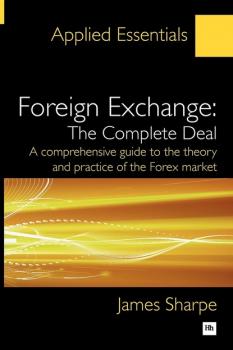Ценные бумаги, инвестиции
Различные книги в жанре Ценные бумаги, инвестицииSupertiming: The Unique Elliott Wave System
The classic work on Elliott Wave and market cycles returned to print
During the 1930s, R. N. Elliott undertook the painstaking procedure of attempting to classify share price movements for the preceding 80 years on Wall Street. It was during the course of this seminal work that Elliott discovered a definable basic rhythm in share price movements which he felt had forecasting value when correctly applied.
In 1938 Elliott published his findings in a series of articles with the overall title «The Wave Principle». After publication, Elliott's work drifted into obscurity, until Robert Beckman's 'Supertiming' introduced it to a new audience.
In this renowned work, Beckman sets out with three main objectives:
1. To clarify obscurities and grey areas of The Wave Principle that were present in Elliott's original writing. 2. To incorporate the work of other analysts in order to allow the Wave Principle to have a broader application. 3. To show the correct conceptual approach that should be used with the Wave Principle so that one can apply it with confidence and consistency.
If you are willing to approach the subject of stock market behaviour with an open mind, who have faith in the fundamental laws of economics and the consistency of human nature, and who would like to avoid the pitfalls that have deluded the investment community for decades, this is the book for you.
How I Made $2 Million in the Stock Market
How I Made $2 million in the Stock Market is an extraordinary book. It tells one of the most unusual success stories in the history of the stock market.
Darvas was not a stock market professional trading on inside information. He was one half of the highest paid dance team in show business, an expert cryptic crossword compiler, and a championship ping pong player. Yet he was able to make himself a millionaire several times over by his unique investment approach. Unlike other so-called systems, it worked regardless of whether the market rose or fell.
When news of Darvas's fantastic profits and methods leaked out, he was featured in Time magazine. He then was persuaded to write a book which became an instant hit, selling nearly 200,000 copies in eight weeks.
Many of the companies talked about in this book no longer exist. Many of the stocks are no longer traded. Nevertheless, the basic principles are as sound as ever.
Goals to Gold
An inspirational journey from footballer to trader
GOALS TO GOLD tells the fascinating and unexpected story of one man's journey from top-flight football to the cut-and-thrust world of the financial markets.
This book also explores the relationship between sports and trading success – making it the perfect book for any sports fan who's ever wondered whether they could make a go of it in the markets.
Lee Sandford spent 17 years as a professional footballer, playing for Portsmouth, Stoke City, Sheffield United and Reading. But when his career was over, he didnâ??t retire to a pundit's sofa or the golf course. He entered another fiercely competitive world: the stock market.
Goals to Gold tells the story of his days as a footballer and subsequent time as a trader, laying bare the sobering facts of a life scattered with huge achievements, near misses and big disappointments.
Part exploration of the unseen side of football and part introduction to financial trading, it shows how the important qualities in football and trading alike are hard work, determination, patience and sticking to your strategy even when the studs-up tackles are flying.
Packed with real-life, behind-the-scenes stories involving promotion, relegation and trophies in football and trading through booms and busts in the markets, Goals to Gold is a gripping and revealing read – perfect for football fan and trader alike.
Behavioral Portfolio Management
The investment industry is on the cusp of a major shift, from Modern Portfolio Theory (MPT) to Behavioral Finance, with Behavioral Portfolio Management (BPM) the next step in this transition. BPM focuses on how to harness the price distortions that are driven by emotional crowds and use this to create superior portfolios. Once markets and investing are viewed through the lens of behavior, and portfolios are constructed on this basis, investable opportunities become readily apparent.
Mastering your emotions is critical to the process and the insights provided by Tom Howard put investors on the path to achieving this. Forty years of Behavioral Science research presents a clear picture of how individuals make decisions; there are few signs of rationality. Indeed, emotional investors sabotage their own efforts in building long-horizon wealth. When this is combined with the misconception that active management is unable to generate superior returns, the typical emotional investor leaves hundreds of thousands, if not millions, of dollars on the table during their investment lifetimes.
Howard moves on to show how industry practice, with its use of the style grid, standard deviation, correlation, maximum drawdown and the Sharpe ratio, has entrenched emotion within investing. The result is that investors construct underperforming, bubble-wrapped portfolios. So if an investor masters their own emotions, they still must challenge the emotionally-based conventional wisdom pervasive throughout the industry. Tom Howard explains how to do this.
Attention is then given to measureable and persistent behavioral factors. These provide investors with a new source of information that has the potential to transform how they think about portfolio management and dramatically improve performance. Behavioral factors can be used to select the best stocks, the best active managers, and the best markets in which to invest.
Once the transition to behavioral finance is made, the emotional measures of MPT will quickly be forgotten and replaced with rational concepts that allow investors to successfully build long-horizon wealth. If you take portfolio construction seriously, it is essential that you make the next step forward towards Behavioral Portfolio Management.
Your Complete Guide to a Successful and Secure Retirement
This is your one-stop, definitive resource as you prepare for a secure and comfortable retirement.
Investment and personal finance experts Larry Swedroe and Kevin Grogan present uniquely comprehensive coverage of every important aspect you need to think about as you approach retirement, including:
Social Security, Medicare, investment planning strategy, portfolio maintenance, preparing your heirs, retirement issues faced by women, the threat of elder financial abuse, going beyond financials to think about your happiness, and much more.
These topics are explained with the help of specialists in each subject. And everything is based on the «science of investing» – evidenced with studies from peer-reviewed journals.
Overall, this adds up to a complete retirement guide, packed with the latest and best knowledge. Don't enter your retirement without it.
Ichimoku Charts
A completely revised and updated second edition of the first book to bring the world of Japanese candlestick charting to English-speaking traders.
In the ten years since the first edition of this book was published, Ichimoku charting, or Cloud charting, has gone from the sole preserve of Japanese traders to being used by traders worldwide. This widespread adoption of the technique can be traced at least in part to this book, since it was the first to introduce the technique to the world outside Japan.
Candlestick charts play an important role in technical analysis worldwide. This book covers the history of candlestick charts – explaining the context in which they developed. It then moves on to explain how in the 1930s a journalist, with the pseudonym Ichimoku Sanjin, started refining candlestick analysis by adding a series of moving averages. The book explains in detail how to construct Cloud charts and how to interpret them. A chapter is devoted to the advanced analysis of Cloud charts, with an in-depth study of the Three Principles: Wave Principle, Price Target and Timespan Principle. The book is illustrated throughout with numerous examples of Cloud chart analysis.
Brand new to this second edition are the author’s thoughts from a further decade of using the technique and new trading examples.
The Smart Financial Advisor
Improving client outcomes with goals-based investing Financial advisors stand at a crossroads. One path is grounded in traditional investing. Advisors who remain on this route face numerous hazards that impair their clients’ long-term wealth and endanger advisory viability. The other path requires practitioners to adapt by embracing technology and goals-based solutions. Choosing the right road is vital for sustaining and growing advisory businesses in the years ahead. Industry veteran and financial technology expert, Bill Martin, CFA, creatively explains how financial advisors can sidestep the seven major hazards their clients face in conventional investing by choosing the smarter path of goals-based investing. This rewarding journey shifts the focus of traditional investing from products and performance towards a collaborative, tech-enabled framework built on personalized advice. Goals-based investing redefines success in terms of achieving each client's unique needs, desires, and aspirations – an approach that clients overwhelmingly prefer and which, crucially, leads to better outcomes for clients and advisors. The Smart Financial Advisor is a must-have guide for advisors who desire to differentiate and grow their practices amid commoditization, fee compression, and increasing regulatory requirements. Martin skillfully combines captivating stories, compelling research, and practical applications to show how you can embark on this path, engaging clients and improving their outcomes along the way. By adopting the fintech and goals-based strategies within this book, not only will you learn the secrets to survive today’s industry challenges, but you will also discover how to truly thrive as a smart financial advisor!
The Guts and Glory of Day Trading
A rediscovered trading classic
Very few day traders make money – let alone $1 million or more – in the daily stock-trading battle. 'The Guts and Glory of Day Trading' tells the true stories of twelve otherwise ordinary people who have made or lost at least $1 million trading stocks. Their triumphant and tragic tales pull back the curtain from the gritty world of day trading to give a rare glimpse of the human emotion, the lives transformed, and the lessons learned, aside from the hype.
Day traders aren't only market gurus and stock brokers, but regular people – classical pianists, burned-out photographers, moonlighting business consultants – who decided to pursue an exciting and treacherous phenomenon to achieve independent success and wealth beyond their wildest dreams. Their stories will inspire you, and – more importantly – show how you can improve your own trading strategies by learning from their successes and avoiding their mistakes.
Every battle has its winners and losers. Every day, thousands of day traders take their battle positions in front of their computers to go head-to-head against the world's best, and most powerful, trading institutions. There are casualties, many casualties. But there are also victories – moments when an individual trader reaches the pinnacle of our capitalist system to take a profit.
Making money isn't easy – with a 75 to 90% failure rate, only the strong survive, and only the most savvy live to trade another day. But despite the negative press, a wildly unpredictable market, and the possibility of losing their shirts on any given trading day, these market mercenaries continue to trade, and day trading continues to grow as a profession. What drives them? In 'The Guts and Glory of Day Trading', you'll read the astounding stories of those traders who have been skilled enough to make significant money, and the gut-wrenching dramas of those who were unfortunate to lose vast fortunes.
Their stories and strategies will keep you on the edge of your seat. These valuable lessons from this trading dozen tell more than just the pits and peaks of stock trading. They teach the survival skills and tactics necessary to live to trade another day. You can learn how to improve your own trading techniques by learning what most of them did right – and what some of them did wrong.
Foreign Exchange: The Complete Deal
The foreign exchange market is the largest and most liquid financial market in the world. In recent years its volatility has been especially pronounced, which has posed problems for investors, companies and governments attempting to manage their economies. The management of exchange rates has become integral to economic performance and to the political landscape.
'Foreign Exchange, The Complete Deal', part of Harriman House's Applied Essentials series, is a comprehensive guide to this broad and exciting market, and how it is traded. James Sharpe, a foreign exchange practitioner with more than 30 years' experience, unravels the important features of the Forex market to give a clear understanding of the issues and processes involved in foreign exchange transactions.
This book begins with an exploration of the historical and theoretical background to the markets as they exist today. The transition from a fixed exchange rate system to a floating system is examined and insight is given on the processes that determine exchange rates and how the system employed impacts government policy. There is also a detailed section about the influence interventions by central banks have on the market.
The focus then moves to foreign exchange in practice, the core of the book. Topics covered include:
– The range of foreign exchange transactions available – including spot, forward, broken date, non-deliverable forwards (NDFs), swaps and options – and how they can be used, with clear worked examples – How foreign exchange prices are quoted; bid-offer spreads; pips – How foreign exposures are hedged – How banks and dealers cover their exposure in the market and make profits – A discussion of tools that are used to analyse the market, including technical analysis – Factors that influence foreign exchange prices on a daily basis including a detailed look at liquidity – How professional traders analyse markets and provide a blueprint for professional trading – How best to choose and manage the relationship with foreign exchange providers
This is an indispensable guide for those who need to understand more about the commercial realities of currency trading and hedging, providing a clear and thorough explanation of the complete world of foreign exchange.
Millard on Channel Analysis
Brian J. Millard uses channel analysis to determine how certain share price cycles, made up of both random movement and predictable cyclical movement, should behave in the near future, giving the investor a powerful prediction tool.
A considerable proportion of price movement is random and as such, investors cannot achieve 100% success in predicting price movement. However, cycles are present in share price data, and channel analysis can be used to determine their position.
Channel analysis enables investors to:
– Rapidly scan a pool of 50-100 shares for new opportunities – Identify the start and end of trends only a few days after the event – Use one of three stop-loss methods as added insurance against extreme random movements
The author also discusses how probability analysis allows the investor to attain a better estimation of channel turning points, leading to greater profit potential. 'Millard on Channel Analysis' is an invaluable guide for any investor who wants to make money by looking at share price cycles.









